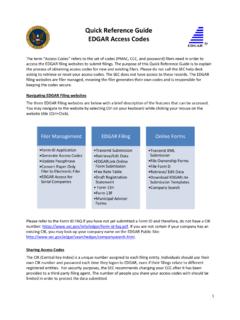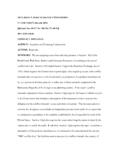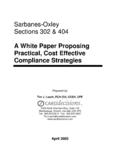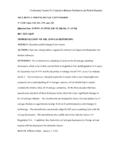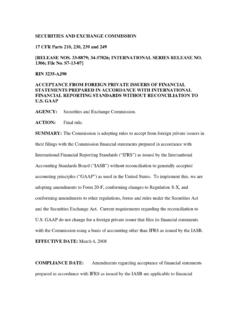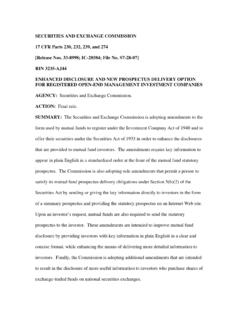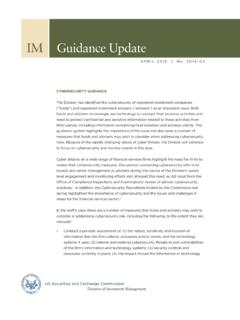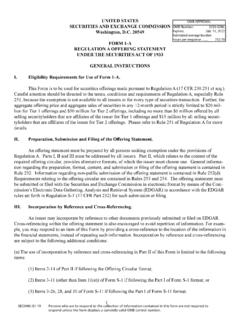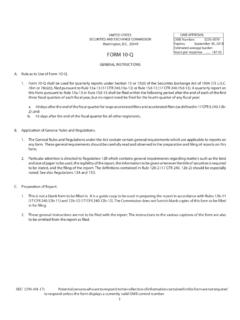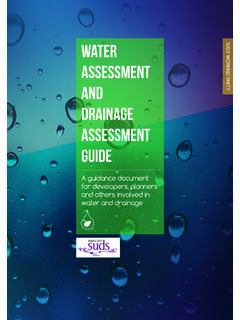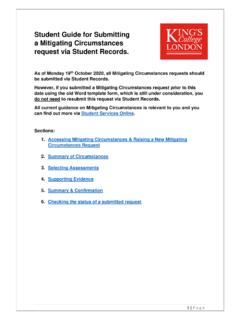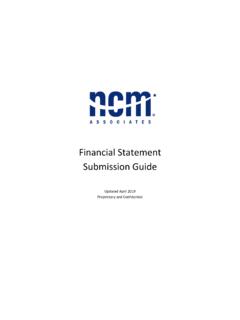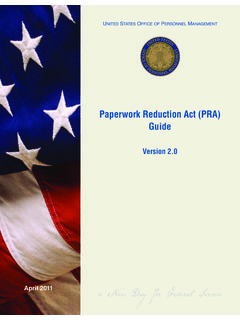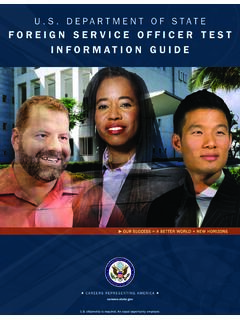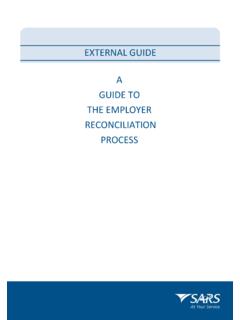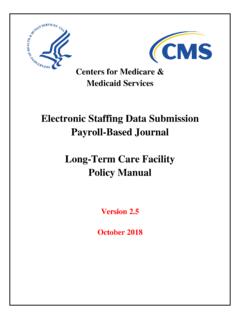Transcription of Privacy Impact Assessment (PIA) Guide
1 Securities and Exchange Commission Office of Information Technology Alexandria, VA Privacy Impact Assessment (PIA) Guide Revised January 2007 Privacy Office Office of Information Technology Privacy Impact Assessment Guide Introduction The E-Government Act of 2002, Section 208, establishes the requirement for agencies to conduct Privacy Impact assessments (PIAs) for electronic information systems and collections1. The Assessment is a practical method of evaluating Privacy in information systems and collections, and documented assurance that Privacy issues have been identified and adequately addressed. The process is designed to Guide SEC system owners and developers in assessing Privacy during the early stages of development and throughout the System Development Life Cycle (SDLC), to determine how their project will affect the Privacy of individuals and whether the project objectives can be met while also protecting Privacy .
2 This Guide provides a framework for conducting Privacy Impact assessments and a methodology for assessing how personally identifiable information is to be managed in information systems within the SEC. PIA Overview Conducting a PIA ensures compliance with laws and regulations governing Privacy and demonstrates the SEC s commitment to protect the Privacy of any personal information we collect, store, retrieve, use and share. It is a comprehensive analysis of how the SEC s electronic information systems and collections handle personally identifiable information (PII). The objective of the PIA is to systematically identify the risks and potential effects of collecting, maintaining, and disseminating PII and to examine and evaluate alternative processes for handling information to mitigate potential Privacy risks.
3 Personally Identifiable Information (PII) PII is information in an IT system or online collection that directly identifies an individual ( , name, address, social security number or other identifying number or code, telephone number, email address, etc.) In addition, PII may be comprised of information by which an agency intends to identify specific individuals in conjunction with other data elements, , indirect identification. These data elements may also include gender, race, birth date, geographic indicator and other descriptors. PII should not be confused with private information. Private information is information that an individual prefers not to make publicly known, , because of the information s sensitive nature. Personally identifiable information is much broader in scope and includes all information that can be used to directly or indirectly identify individuals.
4 PIAs require analysis of broader PII issues, not just the narrower private aspects. 1 See OMB Memorandum (M-03-22) Guidance for Implementing the Privacy Provisions of The E-Government Act of 2002. Revised 2007 2 Privacy Impact Assessment Guide PIA Requirements A PIA should be completed when any of the following activities occur: 1. Developing, or procuring any new technologies or systems that handle or collect personal information. - A PIA is required for all Exhibit 300 submissions, which serve as budget justification and reporting requirements for major information technology The PIA should show that Privacy was considered from the beginning stage of system development. If a program is beginning with a pilot, a PIA is required prior to the commencement of the pilot test.
5 2. Developing system revisions. - If an existing system is modified, a PIA may be required. (See Appendix A for activities that may trigger the need for a PIA) 3. Initiating a new electronic collection of information in identifiable form for 10 or more persons, consistent with the Paperwork Reduction Act (PRA). - This requirement includes any representation of information that permits the identity of an individual to be reasonably inferred by either direct or indirect means. For additional information, contact the SEC s PRA liaison located in the Office of Information Technology, Information Resources Management Branch. 4. Issuing a new or updated rulemaking that affects personal information. - A PIA is required for collections of new information or update to existing collections as part of a rulemaking.
6 The PIA should discuss how the management of these new collections ensures conformity with Privacy laws. Even if a program has specific authority to collect certain information, a PIA is required. 5. Categorizing System Security Controls as High-Major or Moderate-Major . - The Privacy Analysis Worksheet (PAW), Appendix B, is required for all systems that are categorized as High-Major or Moderate-Major , even if the system does not handle or collect personal information. The PAW serves as justification that Privacy was assessed for this Major system. (Contact OIT Security at for assistance.) A PIA is NOT required in the following instances: 1. For government-run Web sites, IT systems, or collections of information that do not collect or maintain information in identifiable form about members of the general public, government employees, contractors, or consultants.
7 2. For government-run public Web sites where the user is given the option of contacting the site operator for the limited purpose of asking questions or providing comments. 3. For national security systems 4. When all elements of a PIA are addressed in a data matching or comparison agreement governed by the computer matching provisions of the Privacy Act. 2 See OMB Circular No. A-11, Part 7, Section 300 Revised 2007 3 Privacy Impact Assessment Guide 5. When all elements of a PIA are addressed in an interagency agreement permitting the merging of data for strictly statistical purposes and where the resulting data are protected from improper disclosure and use under Title V of the E-Government Act. 6.
8 When developing IT systems or collecting non-identifiable information for a discrete purpose that does not involve matching with or retrieval from other databases that generate individual or business identifiable information. 7. For minor changes to an IT system or collection that do not create new Privacy risks. Appendix A provides detailed examples of conditions that would prompt the need for a new or updated PIA. PIA Requirements Related to Privacy Act Systems of Records Notice (SORN) The Privacy Act requires agencies to publish a System of Records Notice (SORN) in the Federal Register that describes the categories of personally identifiable information collected, maintained and used in an automated system. In order for the system to fall under the requirements of a Privacy Act system of records, personal information must be collected on an individual AND retrieved by the individual s name or unique identifier, , SS#.
9 If personal information is collected but never retrieved by the unique identifier, it is not a system of records and a SORN is not required for the system. Under the statute, any officer or employee who knowingly and willfully maintains a system of records without meeting the Privacy Act notice requirements (5 552a(e)(4)) is guilty of a misdemeanor and may be fined up to $5000. The PIA The PIA is an analysis of how personally identifiable information is collected, stored, protected, shared and managed. It identifies and assesses Privacy implications in automated information systems. The system owner initiates the process by completing the Privacy Analysis Worksheet3. The responses on this worksheet will determine whether the proposed project meets the criteria requiring a full PIA.
10 If required, the system owner conducts the PIA using the PIA Template4 and the accompanying PIA Writing Guide5. The system owner responds to Privacy -related questions regarding: Data in the system ( , what data is collected and why) Attributes of the data ( , use and accuracy) Sharing practices Notice to Individuals to Consent/Decline Use ( , SORN) Access to data ( , Administrative and Technological Controls) 3 See Appendix B 4 See Appendix C 5 See Appendix D Revised 2007 4 Privacy Impact Assessment Guide All questions in the PIA Template may not be relevant to every system or may not reflect all the considerations that will be important for a particular system. During the process, the system owner may need to consult with the Chief Privacy Officer, Records Officer, PRA Liaison, and system developer.
